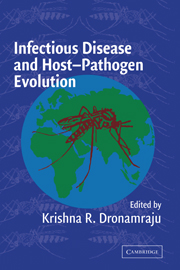Book contents
- Frontmatter
- Contents
- List of Contributors
- Introduction
- PART ONE J. B. S. HALDANE
- PART TWO MALARIAL PARASITES
- PART THREE OTHER PARASITES
- PART FOUR GENETIC AND EVOLUTIONARY CONSIDERATIONS
- 11 The Evolution of Pathogen Virulence in Response to Animal and Public Health Interventions
- 12 Infection and the Diversity of Regulatory DNA
- 13 Genetic Epidemiology of Infectious Diseases: The First Half-Century
- 14 The Impact of Human Genetic Diversity on the Transmission and Severity of Infectious Diseases
- 15 Evolution and the Etiology of Diabetes Mellitus
- 16 The Future of Human Evolution
- Index
- Plate Section
- References
11 - The Evolution of Pathogen Virulence in Response to Animal and Public Health Interventions
Published online by Cambridge University Press: 10 August 2009
- Frontmatter
- Contents
- List of Contributors
- Introduction
- PART ONE J. B. S. HALDANE
- PART TWO MALARIAL PARASITES
- PART THREE OTHER PARASITES
- PART FOUR GENETIC AND EVOLUTIONARY CONSIDERATIONS
- 11 The Evolution of Pathogen Virulence in Response to Animal and Public Health Interventions
- 12 Infection and the Diversity of Regulatory DNA
- 13 Genetic Epidemiology of Infectious Diseases: The First Half-Century
- 14 The Impact of Human Genetic Diversity on the Transmission and Severity of Infectious Diseases
- 15 Evolution and the Etiology of Diabetes Mellitus
- 16 The Future of Human Evolution
- Index
- Plate Section
- References
Summary
INTRODUCTION
Pathogen evolution poses the critical challenge for infectious disease management in the twenty-first century. As is already painfully obvious in many parts of the world, the spread of drug-resistant and vaccine-escape (epitope) mutants can impair and even debilitate public and animal health programs. But there may also be another way in which pathogen evolution can erode the effectiveness of medical and veterinary interventions. Virulence- and transmission-related traits are intimately linked to pathogen fitness and are almost always genetically variable in pathogen populations. They can therefore evolve. Moreover, virulence and infectiousness are the target of medical and veterinary interventions. Here, we focus on vaccination and ask whether large-scale immunization programs might impose selection that results in the evolution of more-virulent pathogens.
The word virulence is used in a variety of ways in different disciplines. We take a parasite-centric view as follows. We use “disease severity” (morbidity and/or mortality) to mean the harm to the host following infection. Disease severity is thus a phenotype measured at the whole-organism (host) level that is determined by host genes, parasite genes, environmental effects, and the interaction between those factors. One component of this is virulence, a phenotypic trait of the pathogen whose expression depends on the host. Thus, virulence is the component of disease severity that is due to pathogen genes, and it can be measured only on a given host. We assume no specificity in the interaction between host and pathogen (more-virulent strains are always more virulent, whatever host they infect).
Information
- Type
- Chapter
- Information
- Infectious Disease and Host-Pathogen Evolution , pp. 265 - 292Publisher: Cambridge University PressPrint publication year: 2004
References
Accessibility standard: Unknown
Why this information is here
This section outlines the accessibility features of this content - including support for screen readers, full keyboard navigation and high-contrast display options. This may not be relevant for you.Accessibility Information
- 7
- Cited by
